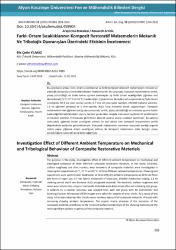Farklı ortam sıcaklıklarının kompozit restoratif malzemelerin mekanik ve tribolojik davranışları üzerindeki etkisinin incelenmesi
Künye
Yılmaz, E. Ç. (2019). Farklı Ortam Sıcaklıklarının Kompozit Restoratif Malzemelerin Mekanik Ve Tribolojik Davranışları Üzerindeki Etkisinin İncelenmesi . Afyon Kocatepe Üniversitesi Fen Ve Mühendislik Bilimleri Dergisi , 19 (1) , 256-263 . DOI: 10.35414/akufemubid.459904Özet
Bu çalışmanın amacı, farklı ortam sıcaklıklarının üç farklı kompozit restoratif malzemesinin mekanik ve tribolojik davranışları üzerindeki etkisinin incelenmesidir. Bu çalışmada, kompozit malzemelerin sertlik, yüzey pürüzlülüğü ve direkt-temas aşınma davranışları üç farklı ortam sıcaklığındaki çiğneme test deneylerinde (5 ℃, 37 ℃ ve 55 ℃) incelenmiştir. Çiğneme test deneyleri saf su içerisinde üç farklı ortam sıcaklığında 50 N üst çene ısırma kuvveti, 0.7 mm alt çene yanal hareketi, 240.000 mekanik yükleme, 1.6 Hz çiğneme periyodu ve 6 mm çapında Al2O3 karşı malzeme olarak uygulanmıştır. Kompozit malzemelerin her çiğneme test grubu sonrasında sertlik, yüzey pürüzlülüğü ve ortalama aşınma hacim kaybı değerleri belirlenmiştir. Ayrıca, her test grubundan rastgele numuneler seçilerek 3D profilometre ve taramalı elektron mikroskobu görüntüleri alınarak aşınma yüzeyi analizleri yapılmıştır. Bu çalışma sonucunda, çiğneme ortam sıcaklığının artması ile test edilen tüm kompozit malzemelerin sertlik değerlerinde azalmalar gözlemlenmiştir. Kompozit malzemenin monomer yapısında içerdiği organik matris yapısı çiğneme ortam sıcaklığının artması ile kompozit malzemenin daha belirgin yüzey pürüzlülüğüne sahip olmasına katkı sağlamıştır. The purpose in this study, investigation effect of different ambient temperature on mechanical and tribological behaviour of three different composite restorative materials. In this study, hardness, surface roughness and direct-contact wear behaviors of composite materials were investigated in chewing test experiments (5 °C, 37 °C and 55 °C) at three different ambient temperatures. Chewing test experiments were performed in distill water at three different ambient temperatures as 50 N bite force bite force of upper jaw, 0.7 mm lateral movement of lower jaw, 240,000 mechanical loading, 1.6 Hz chewing period and 6 mm diameter Al2O3 antagonist material. The hardness, surface roughness and mean wear volume loss values of composite materials were determined after each chewing test group. In addition to, a random specimen was selected from each test group with 3D profilometer and Scanning Electron Microscope (SEM) images were taken for analysis of wear tracks. As a result of this study, it has been observed that the decrease hardness values of all composite materials of tested with increasing chewing ambient temperature. The organic matrix structure of the monomer of the composite material contributes to the increased surface temperature of the chewing material and the more significant surface roughness of the composite material.
Kaynak
Fen ve Mühendislik Bilimleri DergisiCilt
19Sayı
1Bağlantı
https://dergipark.org.tr/tr/download/article-file/718201https://hdl.handle.net/11630/11147
Koleksiyonlar
- Cilt 19 : Sayı 1 [31]



















